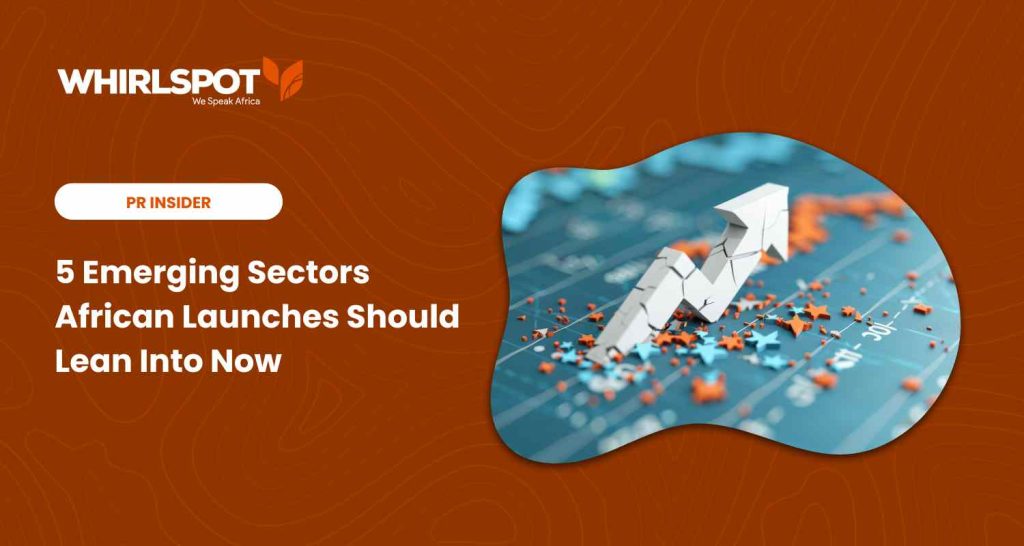Emerging sectors in Africa are redefining the continent’s growth story. With 1.4 billion people, a rising middle class, and tech adoption outpacing infrastructure, Africa is no longer “the next big thing”, it’s the growth engine of today.
In 2024 alone, African startups raised $2.21 billion across 488 deals, with fintech leading the charge. These are not experiments; they’re scaled businesses reshaping entire economies. Fintech alone captured 38% of that funding, while the number of African fintech companies jumped from 450 in 2020 to 1,263 in early 2024. These aren’t experiments; these are scaled businesses reshaping economies.
For CEOs and investors, the real question isn’t “Should we enter Africa?”
It’s “Which sectors will deliver sustainable growth and early-mover advantage?”
These five emerging sectors in Africa will shape the next decade—and smart brands are already making their move.”
1. Fintech: Africa’s Financial Infrastructure
Fintech is the backbone of modern commerce. Mobile money transactions hit $695 billion in Sub-Saharan Africa in 2023 (GSMA), and the sector still attracted $857 million in funding in 2024, even as global venture funding tightened (Empower Africa).
The reason is that banking penetration in many African markets remains below 50%, but mobile adoption exceeds 80%.

Solutions like Kenya’s M-Pesa process over $50 billion annually, while Flutterwave and Paystack are powering cross-border transactions and digital lending at scale.
Whirlspot insight:
When we advise global brands on African market entry, payments always come first. If your payment flow fails, your entire go-to-market strategy collapses.
Building on trusted local rails is the fastest route to credibility and scale.
Read also: Scaling Fintech and Payment Startups in Africa
2. E-Commerce & Logistics: The $75B Opportunity (If You Solve Delivery)
Africa’s e-commerce market is projected to hit $75 billion by 2025 (UNCTAD). But the real challenge is logistics, not just about building online stores. Poor road networks, inconsistent addresses, and high delivery costs make last-mile delivery a deal-breaker.
Local players like Jumia didn’t just adapt Western e-commerce, they rebuilt it. Motorcycle fleets, micro-fulfillment hubs, and cashless delivery models allow them to reach consumers global giants struggle to serve.

Key takeaway:
Entering Africa’s digital commerce space without a logistics strategy is a recipe for failure. Global brands that partner with local innovators rather than replicating Amazon’s playbook, will more likely win faster and at lower cost.
3. Agri-Tech: Closing a $300B Productivity Gap
Agriculture employs 60% of Africa’s workforce but contributes just 23% of GDP, according to the African Development Bank. That gap signals inefficiency and massive opportunity. In 2024, agri-tech ventures secured $50 million in funding (Empower Africa), driven by innovations like AI-powered soil monitoring, drone mapping, and blockchain traceability.

Platforms such as Farmcrowdy and iCow in Nigeria and Kenya respectively, are connecting smallholder farmers to financing and markets, creating structured supply chains where chaos once ruled.
Why it matters for global brands:
Agri-tech is more about securing reliable supply for food, beverage, and FMCG sectors (not just farming). Companies investing in farmer aggregation, input financing, and direct sourcing now will control future food chains.
4. HealthTech: Closing Africa’s 10-to-1 Doctor Gap
Most Sub-Saharan African countries have only 2–4 doctors per 10,000 people, compared to 25–40 in developed nations (WHO Global Health Workforce Statistics, 2024). With just seven countries meeting WHO’s benchmark, telemedicine becomes a survival infrastructure, rather than just a convenience.
The sector gained significant momentum as COVID-19 accelerated digital health adoption across the continent.

Platforms like mPharma (Ghana) and Daktari Africa (Kenya) are building models that merge telemedicine, e-pharmacy, and diagnostics into mobile-first systems. The next frontier are Mental health support, chronic disease management, and AI-powered preventive care.
Our take: The brands succeeding here are not replacing hospitals but extending them. Winning models integrate with public health systems and empower community workers instead of competing with them.
5. Renewable Energy: The Continent’s Biggest Infrastructure Play
600 million Africans lack electricity access (IEA), making renewables one of the continent’s most urgent and profitable sectors. Companies like M-Kopa and Azuri Technologies are scaling pay-as-you-go solar systems, combining hardware with mobile payments for affordability.
For industrial users, (mining, manufacturing, and processing) renewables are displacing diesel for cost and reliability. With energy demand rising and grids under strain, distributed solar, smart storage, and microgrids are becoming immediate solutions.

Opportunity: Africa can leapfrog traditional grids the same way it leapfrogged landlines with mobile. The brands entering now aren’t just selling power, they’re building the continent’s energy backbone.
Read also: 5 Questions Smart Brands Ask Before Their African Market Entry Strategy
Why Emerging Sectors in Africa Define the Next Decade
These sectors aren’t “trends”, they’re the pillars of Africa’s economic transformation. Waiting for “market maturity” is the fastest way to lose first-mover advantage. Local companies are scaling fast, and late entrants will fight for margins instead of market share.
Winning in Africa demands more than capital. It requires local partnerships, deep regulatory navigation, and a PR-first strategy to build trust and credibility. That’s how brands position themselves as long-term growth partners.
Ready to make Africa your next growth story? Talk to Whirlspot Media about market entry strategies that deliver traction where it counts.
FAQ: African Market Entry
Which industry is growing fastest in Africa?
Fintech leads, capturing 38% of all tech investments in 2024, driven by mobile money and payment infrastructure.
What are the best sectors to invest in?
Fintech, e-commerce & logistics, agri-tech, health-tech, and renewable energy dominate due to scale potential and urgent needs.
Why should global brands enter Africa now?
Infrastructure gaps are creating leapfrog innovations, early movers lock in advantage before competition escalates.
What’s the typical investment range for entry?
Partnership-based pilots start around $100K–$500K. Full operations range from $2M–$10M, depending on sector.
What are the biggest risks?
Regulatory changes, currency volatility, and fragmented infrastructure. The biggest risk? Waiting too long.
In Conclusion, success in emerging sectors in Africa demands more than capital. It requires partnerships, cultural fluency, and trust-driven PR.






